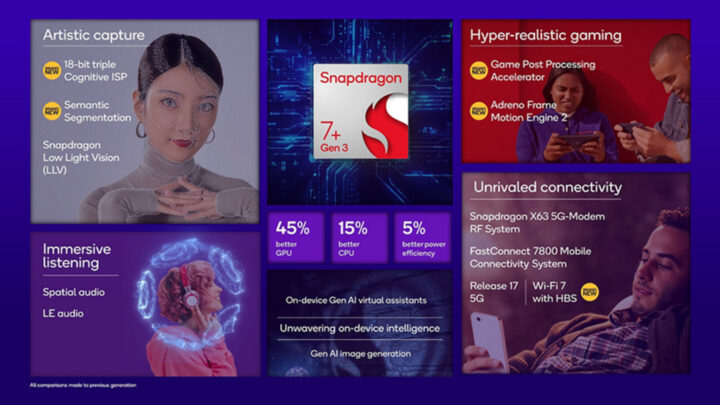[ad_1]
Qualcomm has unveiled a new processor—Snapdragon 7+ Gen 3—for higher mid-range phones and flagship killer devices. It’s the first Snapdragon 7 series mobile processor to feature on-device AI processing, Wi-Fi 7 connectivity, and a Cortex-X4 CPU core.
OnePlus, Realme, and Sharp will be among the first smartphone brands to launch devices with the Snapdragon 7+ Gen 3.
Snapdragon 7+ Gen 3 is a higher mid-range processor for smartphones
The Snapdragon 7+ Gen 3 (SM7675) is fabricated on TSMC’s 4nm (N4P) process node. It is the most affordable processor from Qualcomm to feature a Cortex-X4 CPU core.
CPU
It has one Cortex-X4 CPU core clocked at 2.8GHz, four Cortex-A720 CPU cores clocked at 2.6GHz, and three Cortex-A520 CPU cores clocked at 1.9GHz. Looking at its CPU cores and their clock speeds, it is clear that the Snapdragon 7+ Gen 3 is a trimmed-down version of the Snapdragon 8s Gen 3, which was launched last week.
GPU
The GPU inside the Snapdragon 7+ Gen 3 is the Adreno 732. It can drive 4K 60Hz or QHD+ 120Hz screens. It supports Dolby Vision, HDR, HDR10+, and HLG. It supports variable refresh rates from 1Hz to 240Hz at Full HD+ resolution, and it can support a resolution of up to 8K with a 30Hz refresh rate. HDR gaming and Adreno Frame Motion Engine 2.0 are supported, but the Snapdragon 7+ Gen 3 doesn’t support ray-tracing.
AI, RAM, Storage
Qualcomm is promising a performance uplift of 15% in CPU, 45% in GPU, and 5% in power efficiency. The chip supports up to 24GB LPDDR5x RAM (quad-channel) and UFS 4.0 storage. The built-in Qualcomm Hexagon NPU can run many Large Language Models (LLMs) and Large Vision Models (LVMs) natively.
Cameras
The Snapdragon 7+ Gen 3 has the built-in Qualcomm Spectra Cognitive ISP (triple 18-bit) that supports up to 200MP camera sensors. It can stream visuals from three 36MP camera sensors, a 64MP+36MP dual-camera setup, or one 108MP camera sensor simultaneously with zero shutter lag. It allows phones to record up to 4K 60fps HDR videos or 1080p 240fps slow-motion videos. Supported HDR formats include Dolby Vision, HDR, HDR10+, HLG, and Ultra HDR.
Advanced camera features, including Computational HDR, Multi Frame Noise Reduction, AI-based autofocus and auto-exposure, AI-based face detection, Real-Time Semantic Segmentation, and Video Super Resolution, are supported as well.
Connectivity
The Snapdragon 7+ Gen 3 uses the Snapdragon X63 5G modem that supports mmWave and sub-6GHz 5G networks (with SA and NSA). It supports peak download speeds of up to 4.2Gbps and peak upload speeds of up to 3.5Gbps. It also supports 5G+5G Dual-SIM Dual Active connections.
Thanks to FastConnect 7800, the Snapdragon 7+ Gen 3 is the first Snapdragon 7 series chip to support Wi-Fi 7 and Bluetooth 5.4 (with LE Audio and Auracast). Support for dual-frequency satellite-based navigation is present, and it supports Beidou, Galileo, GLONASS, GPS, NavIC, and QZSS. It supports lane-level accuracy for cars and sidewalk-level accuracy while walking.
NFC and USB 3.1 Gen 2 Type-C are supported as well.
Fast charging and fingerprint
It supports up to Qualcomm 3D Sonic Max fingerprint reader and Quick Charge 5 (based on USB PD) for up to 100W fast charging.
Qualcomm expects the Snapdragon 7+ Gen 3 processor to be used in phones priced in the $400-$600 price segment. Although, most phones powered by this chipset are expected to be launched only in China, India, and other Southeast Asian countries.
Author’s Note: The Snapdragon 7+ Gen 3 processor is an improvement over last year’s Snapdragon 7+ Gen 2. It brings notable improvements in CPU and GPU performance but lacks ray-tracing support for games. To get that feature, consumers would have to opt for slightly higher-priced phones that use at least the Snapdragon 8s Gen 3 processor that was launched a few days ago.
This chipset would be good enough in terms of camera performance for most users. However, enthusiasts who want features like 8K video recording would have to upgrade to phones with the Snapdragon 8 series processors. This chipset would be a great fit for phones like the Galaxy S24 FE or Galaxy S25 FE, but knowing Samsung, it might not use this processor in its phones.
[ad_2]
Source Article Link


